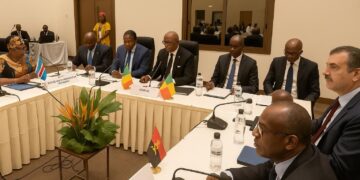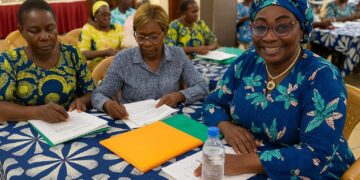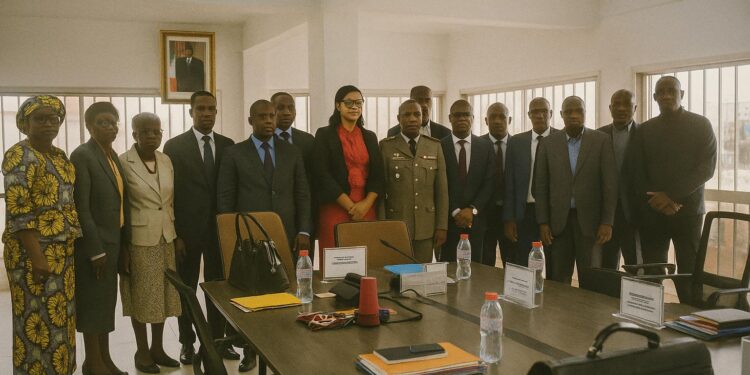Governance signals from the July Board sitting
Rarely does a routine mid-year board meeting stir diplomatic curiosity, yet the 26 July session of Congo-Brazzaville’s Centrale d’Achat des Médicaments Essentiels et Produits de Santé (Cameps) provided precisely such quiet reverberations. Nineteen of the twenty administrators, chaired by veteran public health strategist Ange Antoine Abéna, validated the 2024 statutory documents, endorsed the external auditor’s unqualified opinion and extended formal quitus to the executive team. In the understated etiquette of Francophone corporate law, that quitus constitutes more than a legal clearance: it is a political endorsement of managerial probity.
Strategic recalibration of the pharmaceutical backbone
Cameps sits at the heart of a national supply chain serving roughly 5.8 million citizens. Its role has expanded since the 2018 National Pharmaceutical Policy pledged to reduce import dependency by 30 per cent by 2025 (Ministry of Health 2019). Against that backdrop, directors expressed satisfaction with rising order-fulfilment rates—reported at 91 per cent in the first semester—while acknowledging persistent logistical bottlenecks along the Pointe-Noire-Brazzaville corridor. The meeting therefore read as a microcosm of the broader governmental agenda that seeks to pair fiscal stringency with supply security, an objective aligned with the African Union’s Pharmaceutical Manufacturing Plan (AU 2023).
Financial discipline under auditor’s spotlight
The clean audit, delivered by an international firm headquartered in Casablanca, underscored credible progress after a 2022 management letter flagged weaknesses in stock valuation. According to the new report, discrepancies between physical counts and book entries fell from 14 per cent to below 4 per cent, aided by bar-code technology introduced with technical assistance from the World Health Organization (WHO 2023). Board members, some of whom concurrently sit on parliamentary committees, drew attention to the near-doubling of the working-capital ratio, a metric often ignored in donor briefings yet decisive for avoiding emergency procurement surcharges.
Codifying procedures for institutional memory
Perhaps the most consequential deliverable of the session was the unveiling of a consolidated manual of administrative, financial and accounting procedures. The 176-page document synthesises regulations previously scattered across ministerial decrees, donor contracts and internal memos. As Director-General Dr Paul-André Okemba explained in corridor remarks, the codification will “anchor institutional memory beyond individual tenure”, an issue that has complicated transitions in agencies across Central Africa. Diplomats assessed the move as a prudent shield against the attrition often triggered by projectised aid cycles.
Regional optics and calibrated partnerships
Governance in the pharmaceutical sphere rarely confines itself to national borders. Cameps maintains framework agreements with the West African Health Organization for pooled procurement of antiretrovirals, while negotiations with the African Medical Supplies Platform were reopened in June, insiders confirmed. These linkages occur alongside domestic initiatives such as the SEZ-based pilot for generic packaging in Ouesso, advanced under a tripartite memorandum with India’s Hetero Labs and the Congolese Ministry of Industrial Development. Board members voiced cautious optimism, noting that the pilot could, if successful, localise up to 12 per cent of annual essential-medicine volumes.
Political economy of pharmaceutical sovereignty
Behind the technical vernacular lies an unmistakable political subtext. President Denis Sassou Nguesso’s 2021–2026 social contract set universal health coverage as a flagship pledge. Institutions such as Cameps operate, therefore, at the intersection of public expectation and macro-fiscal prudence. Diplomatic sources recount that Brazzaville has quietly rebuffed offers of concessionary import lines deemed to erode domestic capacity, preferring instead a phased localisation approach that synchronises with the Central African Economic and Monetary Community’s tariff reforms. The Board’s communiqué, while ceremoniously neutral, dovetails with that posture, praising the executive team for “aligning operational tactics with national sovereignty objectives”.
Prospects and calibrated caution
Forecasts enclosed in the management report project a five-year compound annual growth rate of 7.1 per cent for Cameps’ turnover, predicated on modest GDP acceleration and gradual health-insurance enrolment. Risks remain: fluctuating freight prices, climate-related transport disruptions along the Congo River and the perennial challenge of foreign-exchange liquidity in a CFA-denominated economy. The Board identified these variables but judged the mitigation architecture—buffer stocks, hedging instruments and the nascent public-private distribution hub—adequate for the current horizon.
Diplomatic takeaways for regional observers
For partners in Geneva, Addis Ababa or Washington, the Cameps session offers a calibrated case study in incremental institutional strengthening within a small, open economy. It shows how technical housekeeping—audits, manuals, minute readings—can accrue geopolitical value when aligned with a broader narrative of pharmaceutical self-reliance. In the words of Board Chair Abéna, “governance is our first line of medical defence”, a formulation that resonates with policymakers who view health security as a pillar of national resilience. The quiet applause that followed his closing gavel may yet echo beyond Brazzaville, inviting nuanced engagement rather than broad-brush scepticism.












































